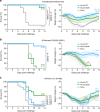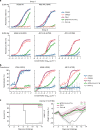Glycan repositioning of influenza hemagglutinin stem facilitates the elicitation of protective cross-group antibody responses
- PMID: 32034141
- PMCID: PMC7005838
- DOI: 10.1038/s41467-020-14579-4
Glycan repositioning of influenza hemagglutinin stem facilitates the elicitation of protective cross-group antibody responses
Abstract
The conserved hemagglutinin (HA) stem has been a focus of universal influenza vaccine efforts. Influenza A group 1 HA stem-nanoparticles have been demonstrated to confer heterosubtypic protection in animals; however, the protection does not extend to group 2 viruses, due in part to differences in glycosylation between group 1 and 2 stems. Here, we show that introducing the group 2 glycan at Asn38HA1 to a group 1 stem-nanoparticle (gN38 variant) based on A/New Caledonia/20/99 (H1N1) broadens antibody responses to cross-react with group 2 HAs. Immunoglobulins elicited by the gN38 variant provide complete protection against group 2 H7N9 virus infection, while the variant loses protection against a group 1 H5N1 virus. The N38HA1 glycan thus is pivotal in directing antibody responses by controlling access to group-determining stem epitopes. Precise targeting of stem-directed antibody responses to the site of vulnerability by glycan repositioning may be a step towards achieving cross-group influenza protection.
Conflict of interest statement
J.C.B., H.M.Y., J.R.M., B.S.G. and M.K. are named inventors of a patent application on stabilized influenza HA stem filed by the National Institutes of Health. All other authors declare no competing interests.
Figures





References
-
- Wharton, S. A., Weis, W., Skehel, J. J. & Wiley, D. C. In The Influenza Viruses 153–173 (Springer, Boston, MA, 1989).
Publication types
MeSH terms
Substances
Grants and funding
LinkOut - more resources
Full Text Sources
Other Literature Sources
Medical
Research Materials

